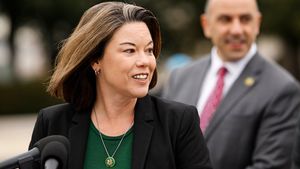In Berlin, watching RuPaul’s Drag Race feels like home. I only follow the U.S. original reality show, now in its 16th season, and the U.K. spinoff. I was not a big Drag Race watcher in America, but now it helps me feel connected to my gay friends across the pond.
But recently, when the show’s contestant Q shared that she is living with HIV, it struck me hard. Q is 26 and tested positive at 24. I was 21.
“It’s crazy how much people with HIV have to deal with,” Q told fellow contestant Plane Jane. “I’ve been treated differently by health care providers. I think it’s so important to have queer people in health care. You really feel that difference.”
Amen, you do. I remembered the day in Georgia 10 years ago when I tested positive, and my doctor said I should rejoin the church. “You really need to think about this lifestyle,” she said.
Here’s the thing about HIV: The goal is to not think about it. In the morning, it’s just a pill, part of a routine. But of course, it’s more than that. It’s a daily reminder that without such a pill, I would die — and all the HIV-positive people I love would die too.
We’ve come a long way, but there are parts of the world where HIV still looks much as it did in 1988. The pills mean my ability to travel, at least for long periods, is stunted. I am yoked to pharmacies and doctors. Countless people across the world see me as a walking contagion. In the 40-plus years of the virus, politicians have tried to brand us with tattoos and corral us into quarantines. Countless numbers of us were kicked out of our homes and rejected by our families. So when a drag queen on one of TV’s most popular shows comes out as HIV-positive and gives airtime to that experience, it matters.
Viewers of Untucked — the behind-the-scenes show following each episode — even saw Q explain what “undetectable” means: Essentially, when you take HIV meds as prescribed, you cannot transmit the virus to anyone.
What a milestone for TV — and for the ongoing role of Drag Race as both a reflection of where the culture stands on HIV stigma and a medium for education. Q inspired me to look back at past contestants who spoke about their status on national (and international) television. Q is the fourth in the franchise thus far. Ongina was the first — in 2009, on season 1 of Drag Race. This was before PrEP, which was FDA-approved in 2012 for daily use in preventing HIV-negative people from acquiring the virus — and which, in my memory, was a major turning point for stigma. This was before the “U=U” campaign led by the nonprofit Prevention Access Campaign, which spread the word that people with an undetectable viral load (as a result of medication) cannot transmit HIV. Even more than PrEP, U=U really changed things for us living with HIV. It meant we were no longer the dangerous, untouchable things society said we were.
Only now can I look back and see how brave Ongina was by coming out when HIV stigma was just worse — an era I hope is passed thanks to such medical breakthroughs. Though Ongina did not win that season, her courage and power count for more than being a drag superstar. Ongina saved lives. Since the show, she has partnered with many HIV groups to continue promoting education and awareness.
HIV was a subplot of that particular episode. Presciently, the main challenge was about modeling for an organization supporting HIV causes. Another contestant, Rebecca Glasscock, broke down in the challenge while thinking of her HIV-positive friend.
“He’s my friend, he’s my sister, and he’s gonna die,” she told the camera. With medication, that was not totally accurate — but possible, and that was certainly the prevailing belief then. In the early 1990s, HIV was the leading cause of death for Americans ages 25 to 44. Roughly a decade later, in that first season, antiretrovirals and integrase inhibitors (better meds) had come, but the drugs were still expensive and had harsh side effects.
After its 2012 approval, PrEP took some time to make headlines. This publication’s reportage on the treatment started in 2013, and the following year Trinity K. Bonet spoke about her HIV-positive status on season 6, becoming the second Drag Race contestant to do so.
Trinity presented her status as a mute fact, not a tearful moment — no crying, no drama — and later told the website Queerty that she did it “because there wasn’t a lot of representation for Black men on television talking about something so stigmatized yet so rampant in our own community.” Out and its sister publications The Advocate and Plus have reported widely that nearly half of all Black men who have sex with men will test positive in their lifetimes, proving that one aspect of the plague years hasn’t changed: People of color are still being failed by health workers and are more at risk of HIV infection and AIDS.
For me, the most powerful HIV coming-out happened in 2021 on the British spin-off, RuPaul’s Drag Race UK, when Charity Kase, just 24, revealed she tested positive at 18. “On dating apps, guys say you’re diseased, you’re disgusting, stay away from me. Just horrible, nasty comments that are really degrading and mean.”
That’s when I lost it — because I got those same messages. Even in a post-PrEP world where undetectable equals untransmittable, those messages come. I got them when I tested positive and still get them now. Charity said she found power in drag during that time, which helped her “celebrate the beauty of darkness.” Just as all my passions — writing, kink, sex — started in those hard months when I thought the world had ended.
That’s how we survive. We start gluing sequins or writing stories. It doesn’t matter how you get through it, just that you do. It breaks my heart that kids still navigate hateful messages and wonder how long they will live. Look at these ages: 25 (Ongina), 21 (Trinity), 18 (Charity). Just kids. But we were all just kids. What made me and these queens different from the kids who came before us, who marched in New York and Washington, is that we lived.
Q’s coming-out sparked opinions on the gay internet. Some said she did it to get a sympathy boost from the judges or add gravitas to her Keith Haring-inspired runway look. These responses track with HIV history: If it’s less fashionable now to shame the virus, let’s at least shame how it is talked about.
What is most remarkable about Q is how her fellow contestants responded: They gave her a hug and moved on. It was momentous because it was not a big moment. It was, in effect, the dream response to HIV — a little love without panic, fear, or ignorance. It was a reminder to audiences that the virus is still around and that those who have it often suffer more from others than from the disease itself.
What a gift to the world, to me, and to all the kids still finding the beauty in the darkness. So thanks, Drag Race, and all the queens who helped move the needle with their stories. Or to quote Plane Jane, “Mama, kudos for saying that. For spilling.”
Alexander Cheves is a writer, sex educator, and author of My Love Is a Beast: Confessions from Unbound Edition Press. @badalexcheves
This article is part of the Out May/June issue, which hits newsstands on May 28. Support queer media and subscribe— or download the issue through Apple News, Zinio, Nook, or PressReader starting May 14.

























































